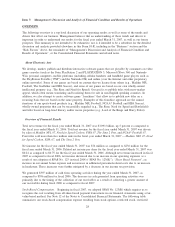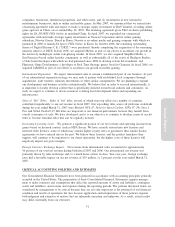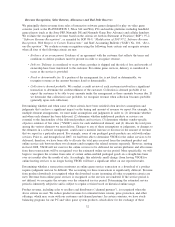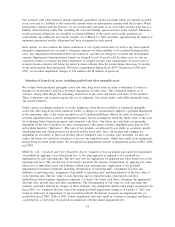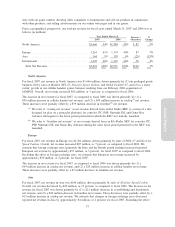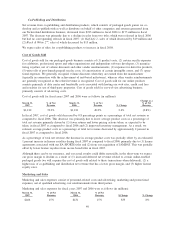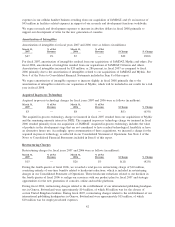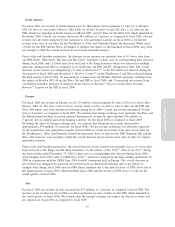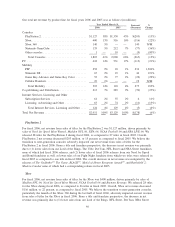Electronic Arts 2007 Annual Report Download - page 110
Download and view the complete annual report
Please find page 110 of the 2007 Electronic Arts annual report below. You can navigate through the pages in the report by either clicking on the pages listed below, or by using the keyword search tool below to find specific information within the annual report.
established to the extent recovery of deferred tax assets is not likely based on our estimation of future taxable
income in each jurisdiction.
In addition, changes in our business, including acquisitions, changes in our international corporate structure,
changes in the geographic location of business functions or assets, changes in the geographic mix and amount
of income, as well as changes in our agreements with tax authorities, valuation allowances, applicable
accounting rules, applicable tax laws and regulations, rulings and interpretations thereof, developments in tax
audit and other matters, and variations in the estimated and actual level of annual pre-tax income can affect
the overall effective income tax rate. As with fiscal 2007, we expect our effective tax rate to be unusually
volatile and subject to significant fluctuation.
RESULTS OF OPERATIONS
Our fiscal year is reported on a 52 or 53-week period that, historically, ended on the final Saturday of March
in each year. Beginning with the fiscal year ended March 31, 2006, our fiscal year ends on the Saturday
nearest March 31. As a result, fiscal 2006 contained 53 weeks with the first quarter containing 14 weeks. Our
results of operations for the fiscal years ended March 31, 2008, 2007, 2006 and 2005 contain the following
number of weeks:
Fiscal Year Ended Number of Weeks Fiscal Period End Date
March 31, 2008......................................... 52weeks March 29, 2008
March 31, 2007......................................... 52weeks March 31, 2007
March 31, 2006......................................... 53weeks April 1, 2006
March 31, 2005......................................... 52weeks March 26, 2005
For simplicity of disclosure, all fiscal periods are referred to as ending on a calendar month end.
Beginning in fiscal 2007, we adopted SFAS No. 123(R) and applied the provisions of SAB No. 107 to our
adoption of SFAS No. 123(R). We elected to use the modified prospective transition method of adoption which
requires that compensation expense be recognized in the financial statements for all awards granted after the
date of adoption as well as for existing awards for which the requisite service has not been rendered as of the
date of adoption. Accordingly, prior periods are not restated for the effect of SFAS No. 123(R). Prior to our
adoption of SFAS No. 123(R), we valued our stock options based on the multiple-award valuation method and
recognized the expense using the accelerated approach over the requisite service period. In conjunction with
our adoption of SFAS No. 123(R), we changed our method of recognizing our stock-based compensation
expense to the straight-line approach over the requisite service period; however, we continue to value our stock
options based on the multiple-award valuation method.
Prior to fiscal 2007, we accounted for stock-based awards to employees using the intrinsic value method in
accordance with Accounting Principles Board No. 25, “Accounting for Stock Issued to Employees” and
adopted the disclosure-only provisions of SFAS No. 123, “Accounting for Stock-Based Compensation”, as
amended. Also, as required by SFAS No. 148, “Accounting for Stock-Based Compensation — Transition and
Disclosure”, we provided pro forma net income and net income per common share disclosures for stock-based
awards as if the fair-value-based method defined in SFAS No. 123 had been applied. As a result, prior periods
are not restated for the effect of SFAS No. 123(R). Pre-tax stock-based compensation expense for the fiscal
years ended March 31, 2007, 2006 and 2005 was $133 million, $3 million and $6 million, respectively.
Comparison of Fiscal 2007 to Fiscal 2006
Net Revenue
We derive net revenue principally from sales of interactive software games designed for play on video game
consoles (such as the PlayStation 2, PLAYSTATION 3, Xbox 360 and Wii), PCs and handheld game players
(such as the Sony PSP, Nintendo DS and Nintendo Game Boy Advance) and cellular handsets. We also derive
net revenue from selling services in connection with some of our online games, programming third-party web
36




